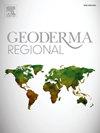Leaching and ammonia emissions in rice fields exhibit greater influences by seasons than management
IF 3.3
2区 农林科学
Q2 SOIL SCIENCE
引用次数: 0
Abstract
Estimation of ammonia (NH3) emissions requires calculation of emission factors (EFs) based on experimental data that reflects seasonal and climatic variability, particularly in an annual triple cropping system. However, data on season-specific EFs under varying climate regimes are required to develop the management strategies that help mitigate nitrogen (N) loss via volatilization. A large portion of N releases into atmosphere from rice soils causing both economic and environmental costs since farmers indiscriminately use N fertilizers for rice production. Ammonia emissions and EFs were assessed in two different rice growing sites with an annual Boro–Aus–Aman sequence. Two sets of treatments were used: two residue treatments (no residue incorporation, NR; and 30 %, by height, crop residue incorporation, CR); and four N levels (control, CL; farmers' practice, FP; recommended nitrogen dose, RD; and 125 % of RD, 125RD). Crop residue incorporation significantly elevated NH3 emissions. CR coupled with 125RD exhibited 10–27 %, 6–7 % and 6–9 % higher NH3 emissions than NR-125RD in Boro, Aus and Aman seasons, respectively. Although the recommended N rate was higher in Boro, NH3 emission was higher in Aman rice (28–34 kg NH3-N ha−1) suggesting that climatic conditions are the most influential driver rather than the N rate. Likewise, NH3 EFs in RD ranged from 11 to 18 %, 16–33 % and 28–34 % in Boro, Aus and Aman seasons, respectively. Our results indicate that NH3 emissions do not only depend on N rate but also on seasons where consideration of seasonal EFs is required to improve NH3 and N budget. By contrast, N rate and crop residue did not influence N leaching but leaching was a considerable part of N loss from rice fields. Overall, our findings underscore the critical need for season-specific N fertilizer management including crop residue incorporation in multi-cropped rice systems to effectively mitigate NH3 emissions while maintaining productivity.
稻田的淋滤和氨排放受季节的影响大于管理的影响
估算氨(NH3)排放需要根据反映季节和气候变化的实验数据计算排放因子(EFs),特别是在一年生三熟制中。然而,需要不同气候条件下的季节性生态系统数据来制定有助于减少氮挥发损失的管理策略。由于农民在水稻生产中不加选择地使用氮肥,很大一部分氮从水稻土壤中释放到大气中,造成了经济和环境成本。利用年度Boro-Aus-Aman序列对两个不同水稻产地的氨排放和EFs进行了评估。试验采用两组处理:两组残茬处理(不掺入残茬,NR;按高度30%,掺入作物残茬,CR);4个氮素水平(对照,CL;农民实践,FP;推荐施氮量,RD和125%的RD, 125RD)。作物残茬掺入显著增加了NH3排放量。在Boro、Aus和Aman季节,CR -125RD的NH3排放量分别比NR-125RD高10 - 27%、6 - 7%和6 - 9%。虽然建议施氮量在波罗稻较高,但氨氮排放量在阿曼稻较高(28-34 kg NH3-N ha - 1),表明气候条件是最重要的驱动因素,而不是施氮量。与此相似,北坡、澳洲和安曼季节的NH3 EFs分别为11% ~ 18%、16 ~ 33%和28 ~ 34%。研究结果表明,NH3排放不仅与N速率有关,而且与季节有关,因此需要考虑季节性EFs来改善NH3和N的收支。施氮量和作物残茬对氮素淋失没有影响,但淋失是稻田氮素损失的重要组成部分。总的来说,我们的研究结果强调了在多茬水稻系统中进行季节性氮肥管理的迫切需要,包括作物残茬的掺入,以有效减少NH3排放,同时保持生产力。
本文章由计算机程序翻译,如有差异,请以英文原文为准。
求助全文
约1分钟内获得全文
求助全文
来源期刊

Geoderma Regional
Agricultural and Biological Sciences-Soil Science
CiteScore
6.10
自引率
7.30%
发文量
122
审稿时长
76 days
期刊介绍:
Global issues require studies and solutions on national and regional levels. Geoderma Regional focuses on studies that increase understanding and advance our scientific knowledge of soils in all regions of the world. The journal embraces every aspect of soil science and welcomes reviews of regional progress.
 求助内容:
求助内容: 应助结果提醒方式:
应助结果提醒方式:


